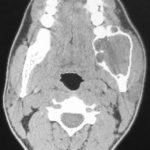
Ameloblastoma is a rare benign odontogenic tumour of epithelial origin with an annual incidence rate of 0.9 per million (Dental Elf – 13th Feb 2019). Ameloblastoma account for about 10% of all jaw tumours and although they are considered benign, they are locally invasive. Three types of ameloblastoma are classified: ameloblastoma (solid/multicystic/conventional ameloblastoma), unicystic ameloblastoma, and peripheral ameloblastoma with solid/multicystic/ameloblastoma being the commonest and most aggressive based on recurrence rates. Treatment is usually surgical using either radical approaches involving en bloc or marginal and segmental resections with wide safety bone margins or conservative approaches involving enucleation, curettage, and marsupialization with adjunctive treatment such as peripheral ostectomy, cryotherapy, or Carnoy’s solution.
The aim of this review was to evaluate the efficacy of various radical and conservative surgical approaches in terms of recurrence rate for the treatment of solid/multicystic ameloblastoma (SMA) patients.
Methods
A protocol was registered in the PROSPERO database with the aim of conducting a network meta-analysis (NMA) according to the PRISMA-NMA guideline. Searches were conducted in the PubMed/Medline, Scopus, ScienceDirect, and Web of Science databases. Randomized (RCTs) and non-randomized clinical trials (n-RCTs) and observational studies, that compared at least two surgical interventions for solid/multicystic ameloblastoma were considered. Two reviewers independently selected studies. Extracted data and assessed risk of bias using the non-randomized studies-of exposure (ROBINS-E) tool. A network meta-analysis (NMA) was conducted to assess and compare the effectiveness of the various treatment approaches. The Confidence in Network Meta-Analysis (CINeMA) web tool was used to assess the certainty of evidence in network meta-analysis.
Results
- 7 retrospective cohort studies with 180 solid/multicystic ameloblastoma patients and 38 recurrences were included.
- The mean age of patients was 36.8 years.
- The most common histopathological subtype was follicular pattern (37%) followed by plexiform (34.7%).
- Surgical approaches to treatment included segmental resection (SR) and marginal resection (MR)
- Conservative treatments included enucleation, enucleation and curettage (ENCU), enucleation with Carnoy’s solution (ECS), and curettage with cryotherapy (CCR).
- The overall risk for all studies was considered to be medium.
- The surface under the cumulative ranking (SUCRA) for the treatments included in the NMA are shown in the table below. With the higher SUCRA value suggesting fewer recurrences.
| Treatment | SUCRA value | Mean rank |
| Segmental resection | 77.7 | 2.1 |
| Curettage with cryotherapy | 66.9 | 2.7 |
| Marginal resection | 49.3 | 3.5 |
| Enucleation with Carnoy’s solution | 45.1 | 3.7 |
| Enucleation and curettage | 43.7 | 3.8 |
| Enucleation | 17.3 | 5.1 |
- The table below compares the odds of recurrence with enucleation against the other treatments.
| Treatment | Odds ratio (95% CI) for recurrence compared to enucleation |
| Segmental resection | 0.22 (0.03 to 1.43) |
| Curettage with cryotherapy | 0.24 (0.01 to 3.98) |
| Marginal resection | 0.39 (0.05 to 2.95) |
| Enucleation with Carnoy’s solution | 0.47 (0.09 to 2.59) |
| Enucleation and curettage | 0.48 (0.05 to 5.05) |
| Enucleation | N/A |
Conclusions
The authors concluded: –
Our network meta-analysis showed segmental resection seemed to be the best treatment approach for reducing recurrence in solid/multicystic ameloblastoma patients. If radical treatment is not feasible for the patient, conservative treatment with multiple approaches, such as curettage with cryotherapy, is indicated. However, the certainty of confidence in the results is still considered weak. Therefore, further studies with optimal methodological standards and long post-operative follow-up duration are needed to strengthen the evidence.
Comments
Previously we considered a review of this question by Hendra et al (Dental Elf – 15th Feb 2019) which included data from 20 retrospective studies and demonstrating pooled recurrence rates for solid ameloblastomas of 8% after radical, and 41% after conservative treatment. This new review from the same group of authors takes a NMA approach aiming to compare a number of treatment approaches for ameloblastomas. As with the previous review only retrospective studies are included and while these were assessed a being at medium risk of bias, they present a great potential risk of bias than prospective studies. Only 7 studies involving 180 ameloblastomas with variable follow-up periods could be included. While a NMA was conducted and the SUCRA ranking provide an indication of the comparable performance in terms of recurrence the findings should be interpreted very cautiously as the available evidence is weak and confidence in the findings low. Well designed, conducted and reported prospective studies with long follow-up periods are needed to improve the certainty of evidence on the management of ameloblastoma.
Links
Primary Paper
Hendra FN, Helder MN, Ruslin M, Van Cann EM, Forouzanfar T. A network meta-analysis assessing the effectiveness of various radical and conservative surgical approaches regarding recurrence in treating solid/multicystic ameloblastomas. Sci Rep. 2023 May 25;13(1):8445. doi: 10.1038/s41598-023-32190-7. PMID: 37231111; PMCID: PMC10213029.
Other references
Dental Elf – 13th Feb 2019
Dental Elf – 15th Feb 2019
Picture Credits
By Berto1286 – Own work, Public Domain
